Korean manufacturer SOtM first came to my attention when I learned that the USB outputs provided stock on computer motherboards weren’t optimal for sound quality, and that SOtM’s advanced USB cards made a significant improvement. Now SOtM offers complete music servers, power supplies, a DAC, and accessories, including several USB cards and digital cables. This review is of their top-of-the-line server, the sMS-1000SQ ($3000 USD), and its external power supply, the sPS-1000 ($1000).

The two components are housed in identical cases of sleek, stylish aluminum available in black or silver, and each measuring 14”W x 2.7”H x 9.5”D; the server weighs 8.8 pounds, the power supply 17.6 pounds. I found the silver cases of my review samples quite attractive -- I thought they bordered on audio jewelry, and so did several visitors. In each the top plate is separated from the front and side panels by a narrow black groove -- in a striking design, it appears to float above the rest of the case. There are no cooling fans; both ran warm to the touch, though not painfully so.
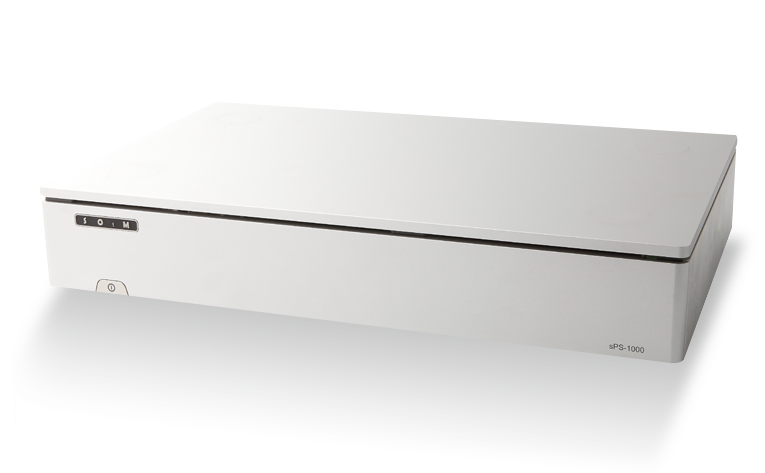
The sPS-1000 not only powers the sMS-1000SQ server, it also provides extremely clean power to the server’s USB 3.0 output jack, which is part of its advanced USB card. Versions of the server are available with S/PDIF and AES/EBU or analog output jacks. Cables are provided to connect the power supply to the server.
The sMS-1000SQ uses the Linux-based Vortexbox or a Windows-based operating system and software. My review sample was the Vortexbox version, for which Logitech’s Media Server software handles the rendering function, playing AAC, AIFF, Apple Lossless, APE, DFF, DSF, FLAC, MP3, MP4, OGG, WAV, and WMA formats. That’s pretty much all formats of interest to audiophiles (and maybe some that aren’t) except for Master Quality Authenticated (MQA), which was not quite a reality when I wrote this. PCM files up to a sampling rate of 384kHz and DSD files up to DSD128 can be played, as well as such streaming services as ickStream, Qobuz, Tidal, Deezer, and various Internet Radio stations. DSD files can be played via PCM protocol or can be converted to PCM for DACs that don’t support the DoP protocol. The Linux-based sMS-1000SQ needs no drivers for USB connection; the Windows version will need a separate driver for each DAC you use -- something that no doubt annoys reviewers more than it does the average audiophile.
Of the sMS-1000SQ’s several possible configurations, the review sample came with the most basic: a 32GB solid-state drive (SSD) for storing the operating system, which meant that my music files had be stored externally. Other versions are available with more internal storage: up to 4TB (hard disk) or 2TB (SSD). For those, an optical drive is an option, with which the sMS-1000SQ can rip CDs to its drive in FLAC format -- CDs are inserted in that narrow groove between top plate and front panel. On the front panel are buttons for Eject CD and On/Off -- that’s all. All other playback controls are accessible via iPeng 8, SOtM’s iPad app. Setup controls can be accessed by a computer over your LAN or via iPeng 8.
On the back of the sMS-1000SQ are the main power switch, a power-cord jack, one USB output, four USB 2.0 input jacks, an RJ-45 jack for connection to your home network, a VGA port for a computer monitor, an HDMI port for a TV used as monitor, a line-out audio port connected to the internal computer’s motherboard, a microphone input connected to the motherboard, and a switch to select between internal and external power for the USB 3.0 output jack. On the back of the sPS-1000 are an IEC jack, an On/Off switch, and three output jacks for whatever devices you want the sPS-1000 to power. Each of these jacks has a small rotary switch with which you can set the output voltage for that jack. Both the sPS-1000 and the sMS-1000SQ have grounding posts.
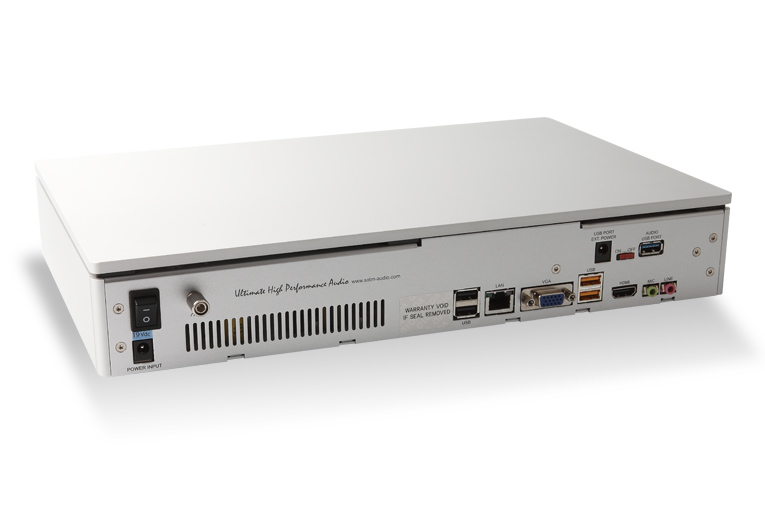
The warranty is for one year -- somewhat skimpy for these prices.
Installing and using the sMS-1000SQ and sPS-1000
The power cords were a bit short, so I stacked the two SOtMs, the server on top. If you use the external power supply for the USB card, you have to flip a switch on the server’s rear panel that tells it to accept external power. The small cables provided were color coded, although the sMS-1000SQ and sPS-1000 themselves were only partially color coded. I would have appreciated a drawing showing how to connect the two boxes. An inline power supply is supplied for use if you don’t opt for an sPS-1000 power supply. The sPS-1000 has a standard IEC connector. I used an Audience powerChord e power cord to connect the sPS-1000 to the wall plug. A special rack for stacking the two units is available, and probably would have been preferable.
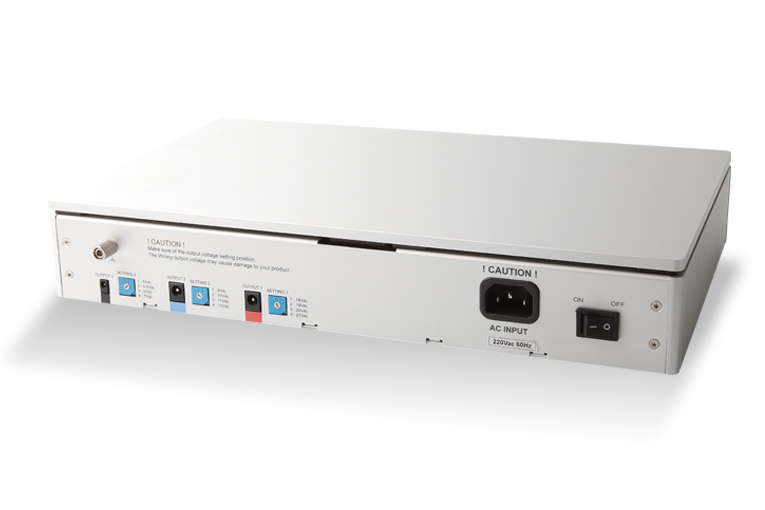
After connecting the power supply to the server and USB output card, I connected the server’s USB 3.0 output jack to my DAC with an Audience Au24 SE USB link, then plugged an Ethernet cable into my home network. That enabled the SOtM server to access the NAS drive on which I store my music files, as well as Wi-Fi -- which meant I could control it using the remote iPeng 8 app. I downloaded iPeng 8 from Apple’s App Store, and was charged for two separate apps, for a total of $13.98.
Manuals for the sMS-1000SQ and sPS-1000 are available on the SOtM website, in eye-straining 8-point type. The first thing I did after downloading the manual was to change the font size to 12 point. Now able to read it, I discovered that the manual is way above average for a server manual, even providing useful instructions for using iPeng 8.
Vortexbox and Logitech’s Squeezebox server work together to provide control of play from any computer on your network -- you can use a laptop or desktop connected to your network via Ethernet or Wi-Fi. Just start your browser and, in the URL field, type in “Vortexbox” or “Vortexbox.local.” You’ll see a Vortexbox graphical user interface (GUI) that looks like a webpage. Click the icon labeled “Squeezebox Server” to bring up the Logitech Media Server GUI, which has essentially the same controls as iPeng 8 but is free. I tried connecting to the Logitech GUI from a laptop running Windows 10 and connected to my home network via Wi-Fi, and it worked well.
The manual gives detailed and easy-to-understand instructions for setting up the Vortexbox server and Logitech playback software, although I discovered statement in the manual can change depending on what file-storage device you plug into the back of the server. That part was not well explained, and had to be set up for me by SOtM remotely over the Internet. Phase 2 of setup was to configure iPeng 8 itself, which I did within the app.
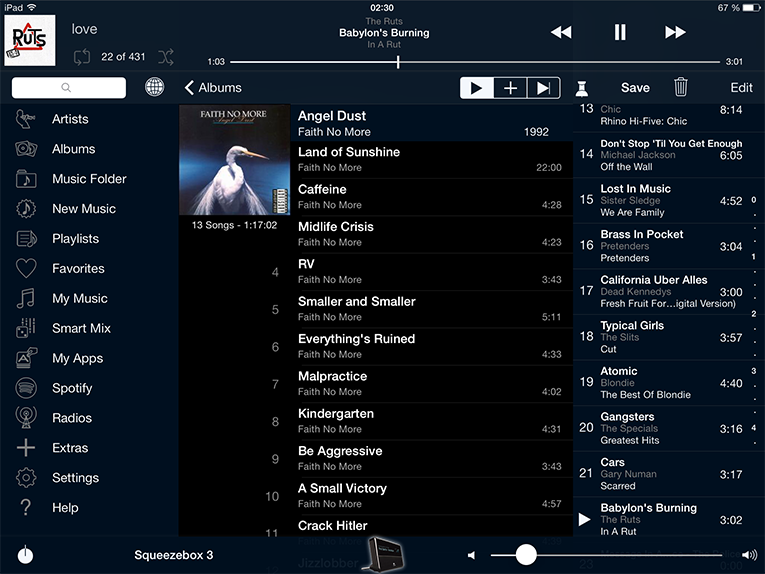
I tried the sMS-1000SQ with three different storage media. First, for a quick start, I plugged a 128GB USB flash drive loaded with several albums into one of the server’s USB 2.0 ports. iPeng 8’s Album view displayed all cover art and played the albums with no problem. Second, I removed the flash drive and connected a portable 2TB Toshiba hard drive containing 1.09TB of files. Vortexbox found the files on the hard drive, and the sMS-1000SQ played them just fine. SOtM says that the sMS-1000SQ will automatically connect to the first partition on a hard drive. That caused a problem when I tried to use an external hard-disk drive; apparently, that drive’s first partition was hidden. It’s a good idea to first format a drive, to ensure that it has only one partition.
Third -- again with remote help from SOtM -- I connected my QNAP NAS drive to the sMS-1000SQ. This was actually the intended configuration for the server. After the NAS’s 1.12TB of files became available to the sMS-1000SQ, I went to Logitech Media Server’s settings menu and told it to rescan the music files, so that they would show up both in the server and on iPeng 8. I had only one problem when using the NAS, and that was resolved by rebooting the NAS. Remember, a NAS is basically just a computer; a reboot can solve all sorts of problems.
I’m neither a networking expert nor a Linux guru, but I’m experienced: I’ve installed and set up a number of servers with only one failure, and that happened only because I tried to use a NAS that was incompatible. However, several times in setting up the SOtMs, I encountered problems that necessitated a call to SOtM tech support, who were able to remotely take over my computer and perform the necessary steps to get me up and running. If you have a dealer who can install the SOtMs for you, I suggest taking advantage of that service -- and then, when you’re up and running, treating him or her to an adult beverage. SOtM recommends ten days’ break-in before doing any critical listening; I let the sMS-1000SQ play 24/7 for that period.
I discovered that iPeng 8 is an excellent playback app, and easily worth $13.98: It was easy to use to find music installed on the NAS. iPeng 8 displayed music in several different ways: by Artist, Composer, Album, Genre, Year, or Date an album was loaded onto your drive, displaying the most recently loaded albums first (theoretically; that feature didn’t always work for me). I could also view music files in a Music Folder view, just as they appear on my computer’s directory or folder. That can be handy if, as always seems to happen, some music files just don’t seem to get recognized the way I expect them to. Into a search field you can enter a song or album title, or an artist’s name. There are also an elaborate settings menu for customizing iPeng 8 and, last but not least, a Help menu that includes tutorials in how to use the app. There’s also a Vortexbox Wiki, an open-content online help system.
Sound
James Horner’s Pas de Deux, with violinist Mari Samuelsen, cellist Hakun Samuelsen, and Vasily Petrenko conducting the Royal Liverpool Philharmonic (24/96 AIFF, Mercury Classics), is an example of what a top film composer can produce in a classical format. A double concerto, Pas de Deux is a beautiful, peaceful work that I’d love to see make its way into the standard concert repertoire. The sMS-1000SQ reproduced it with considerable spaciousness and very well-defined instrumental harmonic structures. The SOtM handled climaxes without compression, making the architecture of the music easy to follow. The bass-drum crash that interrupts the languid first movement was reproduced with power and detail.
The sMS-1000SQ laid out old fave “Folia Rodrigo Martinez,” from Jordi Savall’s La Folia 1490-1701 (16/44.1 AIFF, Alia Vox), with a more spacious soundstage than I usually hear from this recording. Instrumental details were unusually well defined -- especially the percussion instruments, which sometimes fade into background mush. The bass, which goes down to somewhere between 20 and 30Hz, was projected with as much power as I’ve heard it, with no loss of detail. Savall’s solo viola da gamba sounded harmonically rich and accurate. Even his humming toward the end of this piece emerged with clarity. I’ve listened to this track hundreds of times, and the sMS-1000SQ’s reproduction of it was one of the best I’ve heard.
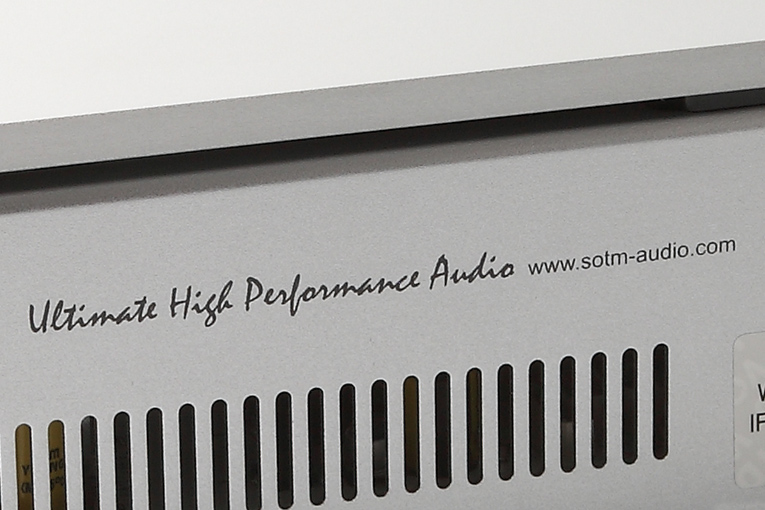
Another old fave, Allegri’s Miserere, performed by the Tallis Scholars (24/96 FLAC, Gimell), has long been my benchmark for soundstaging. In this a cappella performance, the main choir is at the front of the soundstage, with a small group of soloists some distance behind them. That’s what I heard from the sMS-1000SQ, with the larger group spread from speaker to speaker -- as spacious a depiction of this recording as I’ve experienced. And the distortion was notably low; sometimes, this piece sounds a bit hard, but not through the SOtM.
The bass in the title track of Shelby Lynne’s Just a Little Lovin’ (DSD64/DSF, Acoustic Sounds) shook my floor. OK, that’s an exaggeration -- nothing has ever shaken my floor, which is a concrete slab -- but the bass did go as low as I’ve heard it, with plenty of power and detail. Through the sMS-1000SQ, Lynne’s voice was quite nuanced and expressive. Through the SOtMs, this track was reproduced as well as I’ve heard it.
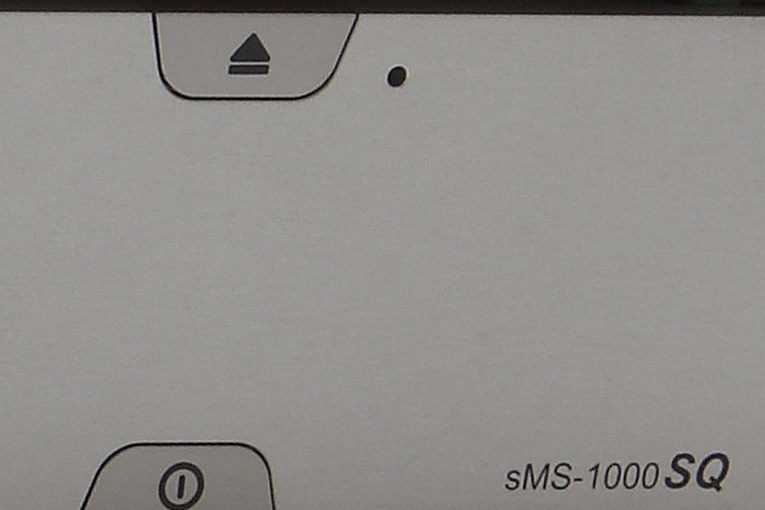
So check off orchestral music, chamber music, choral music, solo female vocal with band -- let’s try a solo instrument. It had been a while since I’d listened to Ottmar Liebert’s One Guitar (24/96 FLAC, Spiral Subwave), so I cued up “Not One, Not Two.” The first notes exploded out of the sMS-1000SQ with real impact, almost startling me. Leading-edge transients were extremely well defined but not exaggerated; they still sounded like the plucked strings of a guitar, and the overall tone of Liebert’s instrument was a very realistic blend of string vibration and body resonance. It sounded as if it was being played in a real room, not an anechoic chamber. Delightful -- which is not a bad adjective for describing how the sMS-1000SQ reproduced music in general.
Comparison
Probably the most basic form of music server is a computer running software such as Roon or JRiver Media Center. Music files can be stored on the computer’s internal hard drive, on an external hard drive, or on a NAS drive. So I compared the sMS-1000SQ and sPS-1000 to my Hewlett-Packard Envy laptop (approx. $850), running Windows 7 and Roon ($119/year). I used the same cables and DAC, and played music stored on the same NAS -- only the source changed. And instead of my iPad, which is too ancient to run the Roon Remote app, I used a second copy of Roon running on another Windows laptop as the remote. That meant that I saw exactly the same screen as appeared on the RoonServer computer.
“Not One, Not Two” sounded as explosive through the computer server as it had through the SOtMs, and similarly spacious, but transients were a smidgen less defined. “Just a Little Lovin’” had very slightly less bass energy but plenty of bass detail. Lynne’s voice also sounded a tiny bit less detailed, but was still very close to how it sounded through the SOtMs. Horner’s Pas de Deux was spacious, but perhaps the instruments sounded slightly less harmonically rich, less organic. Dynamic contrasts were quite good, however. “Folia Rodrigo Martinez” revealed perhaps the biggest differences: The percussion instruments sounded a bit less defined from the computer server, tending to fade into the background a little more. Bass was plentiful, and equally well defined. Overall, this information-rich recording was reproduced with slightly less detail and tonal beauty by my H-P running Windows 7 and Roon. The soundstage of Allegri’s Miserere was just as wide and deep, though the sound was perhaps slightly more threadbare.
Bottom line
The SOtM sMS-1000SQ with sPS-1000 power supply sounded great, and the H-P Envy laptop running Windows and Roon only a tiny bit less great. So is the SOtM pairing, at $4000, worth four times as much as the laptop server? Soundwise, the sMS-1000SQ went way past the point of diminishing returns -- you pay a hefty price for its sonic advantages. But the SOtMs have other advantages: for one thing, they don’t look like a computer. They look like audio components, and doggone attractive ones at that. And the sMS-1000SQ can be configured to work as a standalone server with internal storage -- if you don’t keep your files on a NAS, you can still play them. If you opt for internal storage, you can also opt for an optical drive that will rip CDs to the internal drive in FLAC format, which would be very convenient.
I really liked the SOtM sMS-1000SQ server and sPS-1000 power supply. They’re gorgeous to look at, even better (if only slightly) to listen to than my computer-based server, and easy to use with the very attractive iPeng 8 remote-control app. Highly recommended.
. . . Vade Forrester
vadef@soundstagenetwork.com
Associated Equipment
- Speakers -- Affirm Audio Lumination speakers, JL Audio Fathom f110 subwoofer
- Amplifier -- Berning ZH-230
- Preamplifier -- Audio Research SP20
- Digital sources -- Hewlett-Packard Envy laptop computer running 64-bit Windows 7 Home Premium and Roon server software; PS Audio DirectStream DAC with Yale OS
- Interconnects -- CablePro Freedom, Clarity Cables Organic
- Digital cable -- Audience Au24 SE USB
- Speaker cables -- Clarity Cables Organic
- Power cords -- Audience powerChord e and Au24 SE LP powerChord, Blue Marble Audio Blue Lightning, Clarity Cables Vortex, Purist Audio Design Venustas
SOtM sMS-1000SQ Music Server
Price: $3000 USD.
SOtM sPS-1000 Power Supply
Price: $1000 USD.
Warranty (both): One year parts and labor.
SOtM
#202, Suseoplaza (1557, Ssangyong-Dong)
84-9, Wolbong 4-ro, Seobuk-Gu
Cheonan-si, Chungnam (P.31171)
Korea
Phone: +82 41-576-7663
Fax: +82 41-576-7664
E-mail: sotm@sotm-audio.com
Website: www.sotm-audio.com






















